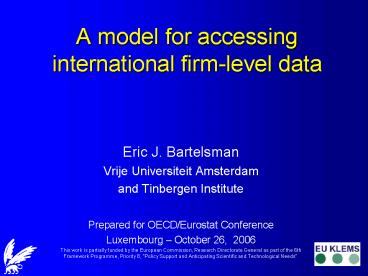A model for accessing international firm-level data - PowerPoint PPT Presentation
1 / 17
Title:
A model for accessing international firm-level data
Description:
Title: Werknemer -- Ondernemer Author: Eric J. Bartelsman Last modified by: Administrator Created Date: 2/17/2003 8:07:20 PM Document presentation format – PowerPoint PPT presentation
Number of Views:64
Avg rating:3.0/5.0
Title: A model for accessing international firm-level data
1
A model for accessing international firm-level
data
- Eric J. Bartelsman
- Vrije Universiteit Amsterdam
- and Tinbergen Institute
- Prepared for OECD/Eurostat Conference
- Luxembourg October 26, 2006
- This work is partially funded by the European
Commission, Research Directorate General as part
of the 6th Framework Programme, Priority 8,
"Policy Support and Anticipating Scientific and
Technological Needs".
2
Overview of Presentation
- What International comparisons of micro-based
indicators - Why Meets urgent policy needs
- How New statistical regulations remote
execution remote access - Who Networked researchers, NSOs, Trusted third
parties - Discussion pros/cons costs/benefits
3
Using Microdata for Analysis
- Policy analysis
- SNA / Final Expenditures GDP demand management
policy - Indicators for structural policy and policy
evaluation microdata - Academic research
- Estimation of behavioral responses
- Microdata at NSOs
- Improve quality of output
- Reduce response burden
- Provide facilities for outsiders
4
International Comparisons
- Not possible to stack data from all countries
- Cross-country variation in intl microdata
research provides - valuable lessons for policy makers
- identification of effects for academics
5
Available Data Sources
Longitudinal Micro Data
National Accounts Industry Data
Macro and Sectoral Timeseries
Surveys, Business Registers
Single country
- SC LMD
EUKLEMS
N.A.
Multiple countries
6
Recent Intl Microdata Research
- There is demand for international comparisons of
micro-based indicators - Firm-level projects for OECD, WB, IADB, Eurostat
- Intl Wage flexibility project (FRB/ECB)
- IPUMS
- Luxembourg Income Studies
7
Firm-Level Projects
- Distributed micro-data analysis
- Harmonized collection of indicators from
longitudinal micro-level business datasets - Firm Demographics Entry/Exit, Survival
- Productivity higher moments, conditional
moments, special tabulations (by size,
ownership status, etc)
8
Firms produce not countries or industries
- Variation in firm-level productivity within
industry or country - A country could have a long tail problem
- Or a lack of world class firms
country1
long tail
- Mean productivity may not be a sufficient policy
indicator
country2
Global frontier
9
10
(No Transcript)
11
Productivity and market contestability
12
(No Transcript)
13
How to generate indicators?
- Eurostat regulation
- After international debate on definitions, NSOs
must supply the requested indicators - Distributed micro-data analysis
- Networked collection, through remote execution
(or remote access)
14
Distributed micro data research
Policy Question Research Design
Researcher
Program Code
Publication
Metadata
Cross-country Tables
Network
Network members
Provision of metadata. Approval of
access. Disclosure analysis
NSOs
15
Network for International Microdata
- Remote execution using meta-data at center, and
network of NSO contacts - Coordination issues
- Secure remote access to confidential data at
trusted center - Technical issues
- Legal issues
16
Participants in Network
- Policy analysts and academics
- Answered research questions
- Spillovers from knowledge launching customer
- NSOs
- Meet user needs fits within organizational
goals learn from best practice improve
reputation - Provide facility Provide expertise and
experience - OECD
- Improved comparability of stats answered policy
questions - Provide institutional support contribute to
analytical capabilities
17
Issues for Discussion
- What are dangers to NSOs and how to minimize
- Confidentiality
- Provider of undisputed data
- Costly sink of resources
- What are benefits to community and how to
maximize - Low marginal costs for research output
- Turnaround time lowered
- Learning from broad-based experience































